The USA Commercial Walk-In Refrigeration Market is estimated to be valued at USD 1.5 billion in 2025 and is projected to reach USD 2.2 billion by 2035, registering a compound annual growth rate (CAGR) of 4.3% over the forecast period.
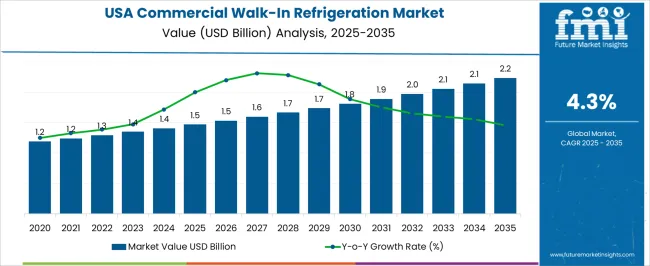
| Metric | Value |
|---|---|
| USA Commercial Walk-In Refrigeration Market Estimated Value in (2025 E) | USD 1.5 billion |
| USA Commercial Walk-In Refrigeration Market Forecast Value in (2035 F) | USD 2.2 billion |
| Forecast CAGR (2025 to 2035) | 4.3% |
The USA commercial walk-in refrigeration market is expanding steadily, driven by evolving cold chain logistics, energy-efficient system upgrades, and rising foodservice demand across retail, healthcare, and hospitality sectors. Strict regulatory mandates for refrigerant transition and temperature compliance have pushed manufacturers to develop sustainable, low-GWP system architectures.
Facility managers and business owners are increasingly investing in customizable, modular refrigeration units to meet space efficiency and uptime needs. Additionally, market growth is being reinforced by technological advances in remote monitoring, IoT-enabled diagnostics, and predictive maintenance capabilities.
With energy codes becoming more stringent across states, there is a notable industry shift toward variable-speed compressors, improved insulation panels, and advanced door-sealing mechanisms. The future trajectory will be influenced by the integration of smart automation, LED lighting retrofits, and demand for dual-temperature compartments in multi-use applications.
The market is segmented by Technology Type, Sales Channel, Place of Use, and End Use and region. By Technology Type, the market is divided into Multiplex Condensing, Self-Contained, and Remote Condensing. In terms of Sales Channel, the market is classified into OEM and Aftermarket. Based on Place of Use, the market is segmented into Indoor and Outdoor. By End Use, the market is divided into Commercial Restaurant, Research Laboratories, Retail Food Services, Hospitals, Pharmaceutical, and Others. Regionally, the market is classified into North America, Latin America, Western Europe, Eastern Europe, Balkan & Baltic Countries, Russia & Belarus, Central Asia, East Asia, South Asia & Pacific, and the Middle East & Africa.
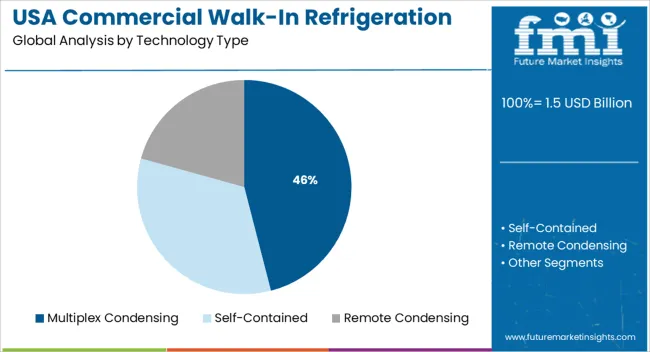
Multiplex condensing systems are projected to account for 46.0% of total market revenue in 2025, making this the leading technology type in the USA commercial walk-in refrigeration segment. This dominance is being driven by their ability to support multiple refrigeration loads through a single, centralized system, which results in reduced installation footprint, lower refrigerant charge, and enhanced energy control.
Supermarkets, large kitchens, and food distribution facilities are increasingly adopting multiplex setups to optimize cooling across varied storage zones while improving efficiency. Regulatory incentives promoting low-emission systems have also accelerated their adoption.
The integration of scroll compressors and smart control units in multiplex systems supports better load balancing, capacity modulation, and diagnostics, which in turn enhances uptime and lifecycle performance. As environmental regulations push toward centralized, energy-optimized cooling infrastructure, multiplex technology is expected to maintain its leadership.
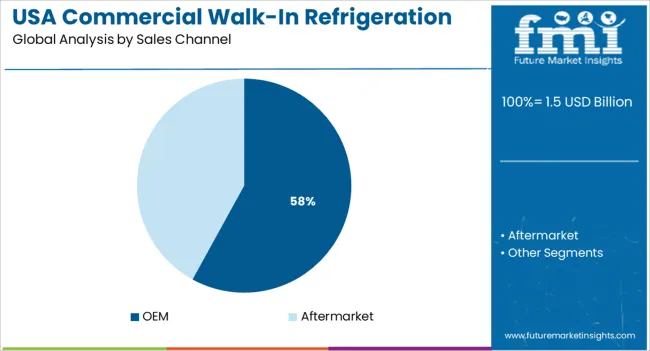
The OEM channel is expected to generate 58.0% of total market revenue in 2025, making it the leading sales channel for commercial walk-in refrigeration systems. This position is being sustained by the direct supply relationships OEMs maintain with large end-users and contractors, enabling customized design, pre-installation quality checks, and faster lead times.
OEMs have increasingly expanded their offerings to include factory-assembled modular systems, which simplify on-site installation and reduce project costs. Their role in meeting compliance with UL, ASHRAE, and EPA standards has positioned them as trusted suppliers for critical cold storage infrastructure.
Furthermore, OEMs are leveraging digital platforms to offer remote commissioning, diagnostics, and post-sale support, increasing adoption across institutional buyers such as foodservice chains, grocery operators, and pharmaceutical storage providers.
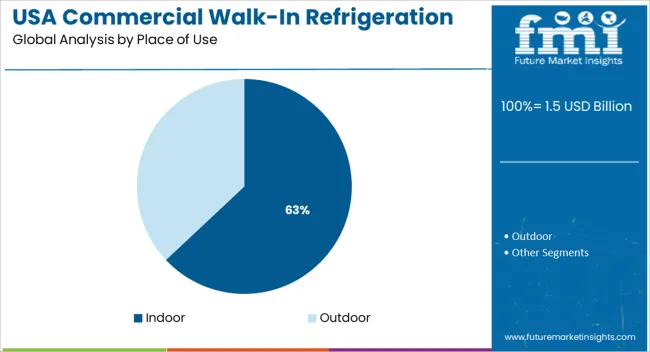
Indoor installations are expected to command 63.0% of market share in 2025, establishing them as the most preferred placement type for commercial walk-in refrigeration units in the USA. This preference is largely driven by the advantages indoor units offer in terms of weather protection, energy stability, and security.
Indoor walk-ins are often integrated into facility layouts for easier access, better workflow management, and reduced exposure to external temperature fluctuations, all of which improve thermal efficiency. Retailers and foodservice operators prefer indoor units due to lower maintenance demands and extended component life compared to outdoor units exposed to environmental stress.
Additionally, indoor placement supports year-round performance optimization, especially in temperature-sensitive sectors such as healthcare, floral storage, and ready-to-eat foodservice. As urban real estate constraints encourage vertical space utilization, the demand for compact, high-capacity indoor refrigeration solutions is expected to remain high.
The demand for the USA Commercial Walk-In Refrigeration market is USD 1,250.4 Million in 2024, increased in value at a CAGR of 1.4% between 2020 and 2024. As per FMI analysis, the USA Commercial Walk-In Refrigeration market is anticipated to grow at 4.3% CAGR by volume between 2025 and 2035.
Walk-In Refrigeration systems are not only used in commercial restaurants for the rising demand for ready-to-eat products in the regular lifestyle but also it is used over chilling stations for food, pharmaceuticals and hospitals, research laboratories, retail stores, and others. On the other side, in order to maintain the supply chain and boost the speed of the production market, manufacturers are enhancing the quality of walk-ins by using high-quality consumables and components such as refrigerants, rain roofs, refrigeration hoods, drip caps & other for Commercial Walk-In Refrigeration.
The growth of the USA Commercial Walk-In Refrigeration Market is anticipated to benefit from the expansion of the various end-use sectors such as F&B, Pharma, commercial food chains, and cold supply chains. In addition, it is projected that the growth of the pharmaceutical industry and the creation of research labs will lead to market expansion across various economies.
For instance, a substantial number of pharmaceutical developments will be visible by the end of 2024 as a consequence of the Covid-19 global pandemic. In a similar vein, it is anticipated that rising demand & development of the pharmaceutical sector will drive demand for commercial walk-in refrigeration systems and boost the market.
Growing Number of Retail Stores and Demand for Ready-to-Eat Products
A shift in lifestyle, particularly in terms of the type of food consumed and the amount of time spent on these activities, poses a significant challenge to the food industry. In order to meet the rising demand from clients for frozen meals and chilled commodities, food service providers are enhancing their capital expenditure on walk-in coolers and freezers. The development in authorized and franchised locations of limited-service restaurants is another factor driving the demand for walk-in coolers and freezers.
On the other hand, the USA market for this business is quite fragmented, which can meet the increased demand for walk-ins caused by the country's rapid expansion in the number of retail outlets over the past few years. Profiting on customers growing purchasing power in the USA, primarily in the South and West, is the ultimate focus of the end-use sector. However, due to the government's encouraging investment policies, the retail industry has grown significantly in these areas.
Rebates for Energy-Efficient Products and Practices from Various Organizations
Manufacturers of commercial walk-in refrigerators are focusing their efforts on research and development (R&D) activities to develop innovative and creative technologies for these systems that may fulfill both consumer demand and governmental norms and regulations. For employing energy-saving and environmentally friendly production techniques, a number of international governmental and non-governmental organizations may offer rebates to manufacturers of walk-in refrigeration systems and equipment.
The Environmental Protection Agency (EPA) and the Department of Energy (DOE) in the USA jointly administer the Energy Star voluntary program. It promotes environmental conservation by adopting strict energy efficiency criteria for walk-in coolers and refrigeration equipment, and it provides subsidies to businesses and people.
By increasing the private sector's supply of renewable energy and lowering energy use through improved energy efficiency, this project helps the USA achieve greater energy independence. Efforts to improve energy efficiency are predicted to increase demand for walk-in coolers and freezers.
Introduction of innovative Walk-in Coolers with Low Environmental Footprint
The producers of walk-in coolers and freezers are concentrating their efforts on developing economically sensible alternatives in order to minimize their environmental impact. Manufacturers are making significant investments in research and development to produce low-GWP refrigerants. HFCs are potent greenhouse gases that are a major cause of global warming. Governments in a number of nations have established stringent rules regulating GHG emissions from refrigerants, and they are placing restrictions on manufacturers.
Due to these laws and regulations, manufacturers are switching to lower-GWP refrigerants in order to comply with environmental standards and boost the energy efficiency of walk-in coolers and freezers. Over the next several years, it is anticipated that the use of lower-GWP refrigerants would increase dramatically in the walk-in cooler and freezer market.
The South USA is expected to account for 42.2% of the USA Commercial Walk-In Refrigeration Market in 2025. West USA is anticipated to hold a significant share followed by South USA of about 23.4% in the USA market owing to stringent regulations and standards by the government.
The Southern area nearly dominates the USA commercial walk-in refrigeration market.
According to FMI, at the beginning of this year 2025, there were more new retailers opening in the USA than the number of stores closing. It produced a net gain of more than 49 million square feet of new retail space, which raised the demand for commercial walk-in refrigerator markets. It provides the southern region of the USA holds the maximum number of shares around 42.2% of the overall USA Commercial Walk-In Refrigeration Market.
Major of the market is covered by commercial restaurants & retail food services which demand the refrigeration system and the southern region is finding considerable growth in retail food services at 19.7% followed by commercial restaurants at 21.8% which have demand for Walk commercial refrigeration systems to preserve the food in good condition and to maintain the food supply chain.
Commercial Restaurants & Retail Food Services is anticipated to grow during the projected period
According to analysis, many retailers aim to appropriately size their store holdings, which may entail a combination of closures and openings. In addition, as consumer buying habits continue to change, retailers are experimenting with new forms. There has been a considerable rise in retail space as a result of the number of retail store closures in the USA being roughly half that of new store openings over the past year.
Consumer choice has changed from FSR (Full Service Restaurants) to QSR (Quick Service Restaurants) due to the rapid change in lifestyles. A quick-service restaurant is one that prioritizes serving food to clients as quickly and effectively as feasible. This typically indicates that there is no table service and that meals are quickly prepared upon request.
The number of quick-service restaurants has significantly increased in recent years. As a result, both international and local businesses are making significant investments in equipment for the same, including walk-in coolers and freezers, along with vending machines and display cases.
Self-Contained technology Type to hold about 42.7% of the USA market share
Self-Contained technology has an advantage over its function when comparing the key market share by technology type. They are cold storage rooms with a complete refrigeration system that includes an evaporator and condenser in a single unit, much like a window air conditioner. Self-contained walk-ins are frequently constructed outside the buildings they serve.
Followed by the Self-Contained technology, remote condensing technology have remarkable shares of 42% in 2025. In walk-in coolers with remote condensing units, the condenser is often not installed exactly next to the room and is not connected to the evaporator, such as on the roof of the building. Many walk-in remote condensing units have many evaporators and are integrated into the structures so they will cool.
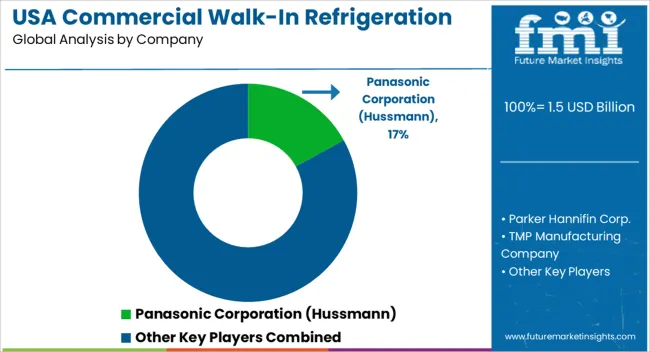
The use of Commercial Walk-In Refrigeration systems has increased across numerous commercial restaurants and retail food services along with pharmaceuticals, as a result of the growing demand for ready-to-eat products and medical requirements. Commercial Walk-In Refrigeration service suppliers are thus under constant pressure to enhance their after-sale services along with improved product quality.
Leading market players operating in the USA Commercial Walk-In Refrigeration Market include Panasonic Corporation (Hussmann), Parker Hannifin Corp., TMP Manufacturing Company, Standex International Corporation, Dover Corporation, Welbilt, Inc., Zero Zone, Inc., USA Cooler, SRC Refrigeration, American Panel Corporation, Arctic Industries Inc., Amerikooler LLC, Commercial Cooling - Par Engineering Inc., Thermo-Kool, Bally Refrigerated Boxes Inc., Norlake Inc., Air Services & Refrigeration Specialties Inc., and others—which control the majority of the market share for Commercial Walk-In Refrigeration System.
Commercial walk-in coolers & freezer market players are strategically expanding their business across the USA by creating mergers & Acquisitions with local as well as emerging players.
| Attributes | Details |
|---|---|
| Forecast Period | 2025 to 2035 |
| Historical Data Available for | 2020 to 2024 |
| Market Analysis | USD Million for Value |
| Key Regions Covered in the USA | North East USA; South USA; Midwest USA; and West USA |
| Key Market Segments Covered | By Technology, By Sales Channel, By Place of Use, and By End Use |
| Key Companies Profiled | Panasonic Corporation (Hussmann); Parker Hannifin Corp.; TMP Manufacturing Company; Standex International Corporation; Dover Corporation; Welbilt, Inc.; Zero Zone, Inc.; USA Cooler; SRC Refrigeration; American Panel Corporation; Arctic Industries Inc.; Amerikooler LLC; Commercial Cooling - Par Engineering Inc.; Thermo-Kool; Bally Refrigerated Boxes Inc.; Norlake Inc.; Air Services & Refrigeration Specialties Inc. |
| Report Coverage | Market Forecast, brand share analysis, competition intelligence, Drivers, Restraints, Opportunities and Threats analysis, Market Dynamics and Challenges, Strategic Growth Initiatives |
| Customization & Pricing | Available upon Request |
The global usa commercial walk-in refrigeration market is estimated to be valued at USD 1.5 billion in 2025.
The market size for the usa commercial walk-in refrigeration market is projected to reach USD 2.2 billion by 2035.
The usa commercial walk-in refrigeration market is expected to grow at a 4.3% CAGR between 2025 and 2035.
The key product types in usa commercial walk-in refrigeration market are multiplex condensing, self-contained and remote condensing.
In terms of sales channel, oem segment to command 58.0% share in the usa commercial walk-in refrigeration market in 2025.






Full Research Suite comprises of:
Market outlook & trends analysis
Interviews & case studies
Strategic recommendations
Vendor profiles & capabilities analysis
5-year forecasts
8 regions and 60+ country-level data splits
Market segment data splits
12 months of continuous data updates
DELIVERED AS:
PDF EXCEL ONLINE
USA Medical Coding Market Size and Share Forecast Outlook 2025 to 2035
USA Labels Market Size and Share Forecast Outlook 2025 to 2035
USA Plant-based Creamers Market Size and Share Forecast Outlook 2025 to 2035
USA Barrier Coated Paper Market Size and Share Forecast Outlook 2025 to 2035
USA Electronic Health Records (EHR) Market Size and Share Forecast Outlook 2025 to 2035
USA Animal Model Market Size and Share Forecast Outlook 2025 to 2035
USA and Canada Packer Bottle Market Size and Share Forecast Outlook 2025 to 2035
USA Stretch Hood Films Market Size and Share Forecast Outlook 2025 to 2035
USA and Canada Fence Screen Market Size and Share Forecast Outlook 2025 to 2035
USA Lubricant Contaminated HDPE Container Waste Market Size and Share Forecast Outlook 2025 to 2035
USA & Canada Pre-painted Steel Roofing and Cladding Market Size and Share Forecast Outlook 2025 to 2035
USA Residential Cotton Candy Maker Market Size and Share Forecast Outlook 2025 to 2035
USA Faith Based Tourism Market Size and Share Forecast Outlook 2025 to 2035
United States NFC Lemon Juice Market Analysis - Size, Growth and Forecast 2025 to 2035
USA and Canada Copper Market Insights - Demand, Size & Industry Trends 2025 to 2035
USA Ground and Precipitated Calcium Carbonate Market Growth by Product Type, Application, End-Use, and Region in 2025 to 2035
United States Animal Feed Additives Market Report – Trends, Growth & Forecast 2025–2035
United States Wild Rice Market Outlook – Size, Demand & Forecast 2025–2035
United States Wood Vinegar Market Analysis – Trends, Growth & Forecast 2025–2035
United States Tartrazine Market Report – Trends, Growth & Forecast 2025–2035

Thank you!
You will receive an email from our Business Development Manager. Please be sure to check your SPAM/JUNK folder too.
Chat With
MaRIA